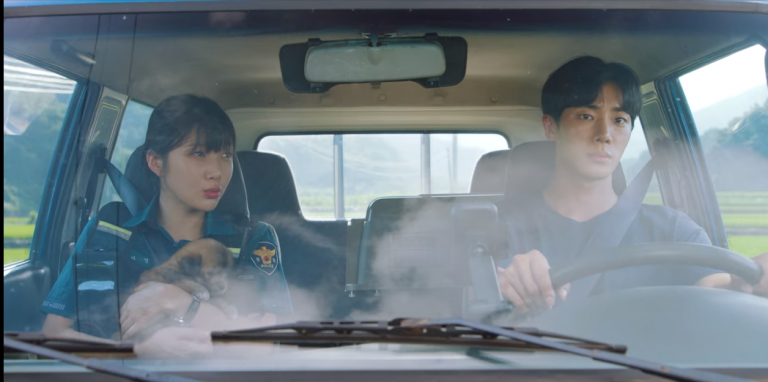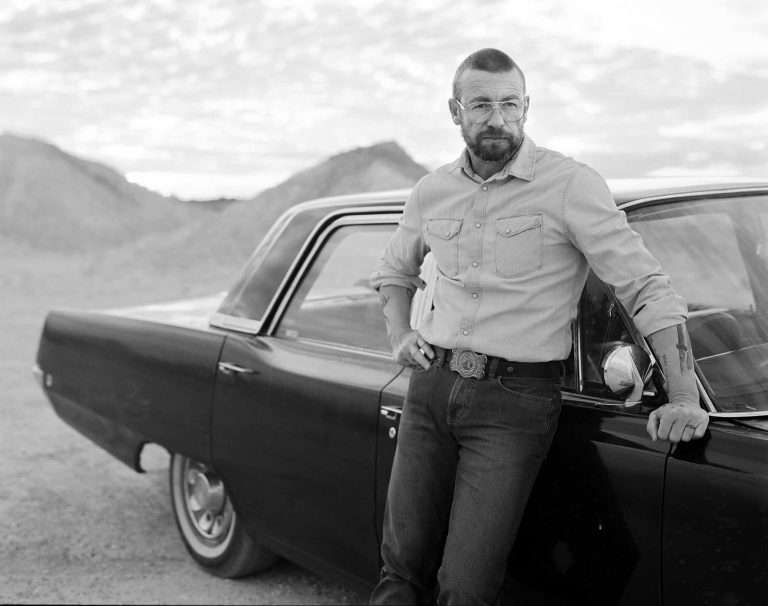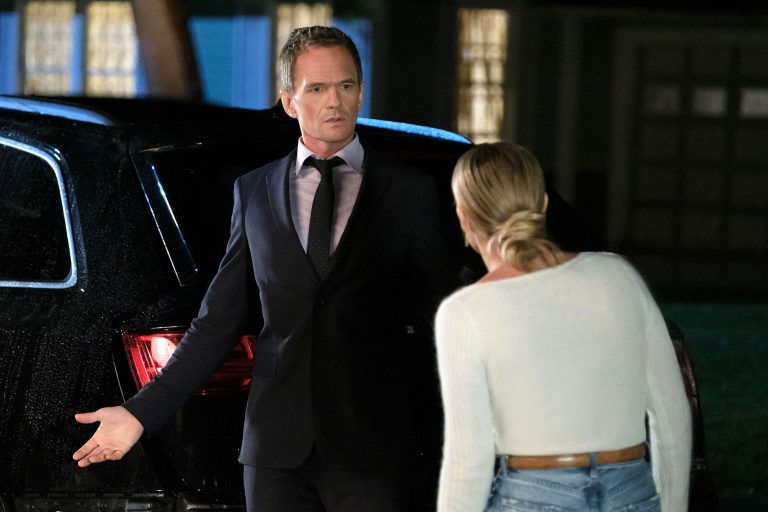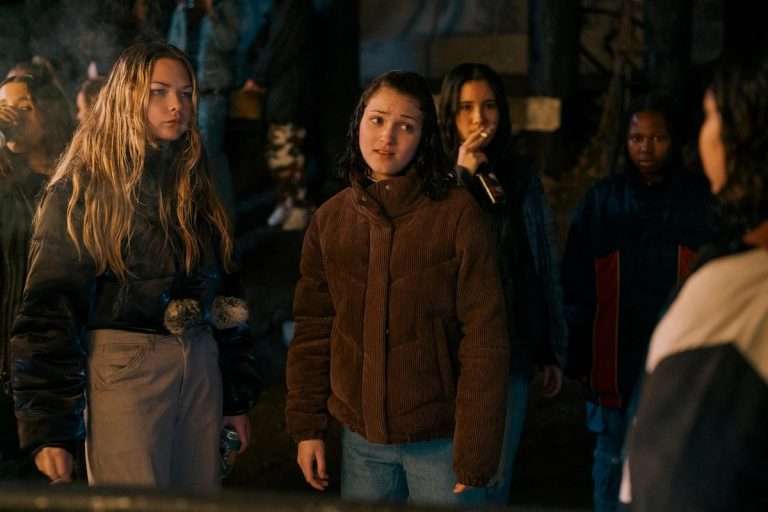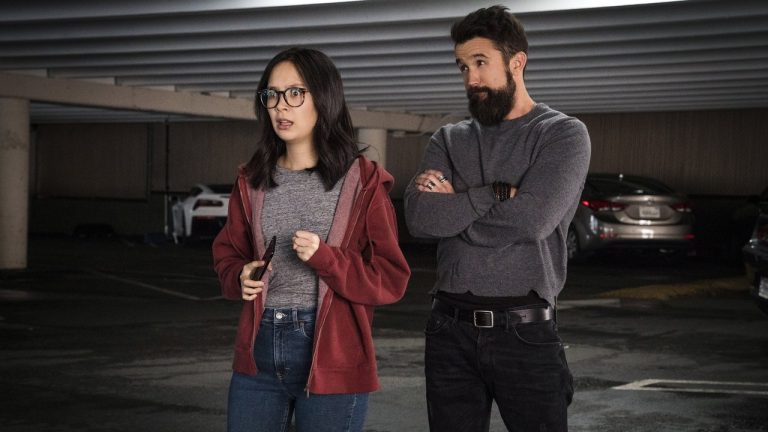Co-creators Jonathan Nolan and Lisa Joy (Westworld), no strangers to high-concept sci-fi storytelling with mystery boxes at their centerpieces, set their sights on Bethesda Game Studios’ Fallout (Season 1). The franchise is a series of video games. Now, it is a television series set in a post-apocalyptic world in an alternate timeline, where 200 years after nuclear warfare, Los Angeles (the center stage of the series) has become an apocalyptic wasteland.
At the same time, many survivors had taken refuge in nuclear fallout shelters called Vaults, ostensibly created to preserve humanity in the hopes of reclaiming the surface one day for repopulation. However, an inciting event in Vault 33 leads a young woman named Lucy to leave behind her home in Vault 33 and venture out into the wasteland to look for her father. Along the way, she meets enemies and befriends allies, including a squire belonging to the Brotherhood of Steel and a mysterious Ghoul bounty hunter, who each have their own scores to settle in the world.
Fallout (Season 1) Recap:
The World
According to Todd Howard, the head of Bethesda Studios (the stewards of the Fallout IP), the setting of the television series is canonical with the games in that the events of the series work within the umbrella of the setting of the games. In that regard, Fallout takes place in an alternate history of the United States, where the atomic age of the 1950s didn’t go out of vogue but evolved and extrapolated.
The setting and technology resemble steampunk aesthetics, where vacuum tubes and atomic physics serve as cornerstones of scientific progression, with extremely advanced computer systems, like robots, and nuclear-powered vehicles existing side-by-side with retro machines like rotary-dial telephones and black-and-white televisions. More importantly, the Cold War political sensibilities, paranoia, and distrust towards Communism never disappeared. The show, when it shuttles to the past, references the events of a war that Cooper Howard (Walton Goggins) had fought in and would reminisce nostalgically about. He also reveals that he would use the T-45 armor, whose successive iteration (T-60) would become the central weaponry for the Brotherhood of Steel.
It might be referring to the Resource Wars of 2052, which would be caused by an energy crisis due to oil depletion, leading to a war between various countries, the disbanding of the United Nations, the US invasion of Mexico, the annexation of Canada, China’s invasion, and eventually the military annexation of Alaska. Tensions would build and skyrocket until the “Great War” of 2077, which would lead to an apocalyptic nuclear exchange for over 2 hours, resulting in the post-apocalyptic nuclear setting of the Fallout world.
The Vaults
It is heavily implied and even referenced in the show, leading to the major theme of the show: capitalism utilizing the events of war to create a monopoly. In 2054, the US government would begin a program to create nuclear fallout shelters called “Vaults.” The work would be contracted to a private company named Vault-Tec, whereby the vaults would be constructed as public shelters (ostensibly). However, the vaults were never intended to be a viable option for the repopulation of the planet.
Over 400,000 vaults were commissioned, but only 122 of them were constructed. Each vault would be self-sufficient, part of a trio of vaults connected in a triangular tunnel system. Each vault would be self-sufficient enough that inhabitants could be housed indefinitely. However, the reality that would also be revealed in the show would be that the vaults were always constructed as a closed-study session where unhealthy scientific and social experiments would be conducted, be it to create clones or hybridize humans with nuclear-resistant creatures.
Ghouls and The Brotherhood of Steel
After the events of the Great War, the United States (because that is the country we are dealing with) has become a post-apocalyptic landscape called “the Wasteland.” The nuclear fallout had left vast expanses of desert and empty landscapes, with large swaths of property left to neglect and filled with dust, allowed to rot. In addition, most food and water on the surface have been bombarded with severe radiation as well as infected with mutagens.
As infrastructure and administration seem nonexistent, bare necessities could only be obtained via barter systems. Settlements were created in ruins, like the town of Filly, made within the ruins of an airplane. There are settlements where grains have been grown or food produced that was unscathed from the radiation, but that is quite rare. Snake oil salesmen would sell rejected or unaccounted-for samples of experimental materials as serums, presumably from the rejected experimentation in the vaults.
Humans who had been unable to get into the vaults in time mostly died out. Some survived, but they became a form of post-humans; lifespans extended greatly, but bodies were slowly damaged and affected by necrosis; vocal cords slowly rotted; voices became raspy; hair loss exhibited; and if allowed to move on, would devolve into zombies if exposed more and more to radiation. These post-humans are known as ghouls.
The Brotherhood of Steel, on the other hand, was a faction consisting of ex-US Army soldiers who had rebelled against the government once they learned of the secret experiments being conducted by Vault-Tec. However, their rebellion couldn’t begin in earnest because of the Great War. Post-Great War, their objectives are twofold: collecting and storing pre-war materials and technology and also perfecting the failed and fallen society—the little that remains in the wasteland.
The hierarchy of the Brotherhood of Steel follows almost like a medieval model: a chain of command consisting of four ranks in ascending order: initiate (squire), knight, Paladin, and elder. There are other factions within this world, like the inhabitants of Vault 15, who would go on to form the settlement of Shady Sands, which would later expand to the New California Republic (NCR), and the Enclave, which would presumably be revealed in the second season.
Fallout (Season 1) Episode 1 – The End
In the year 2077, actor Cooper Howard (Walton Goggins) and his daughter are busy entertaining at a birthday party for the kid of a wealthy industrialist. In the middle of the party, the great war begins, and Howard and his daughter are caught in the middle of the nuclear exchange. Flash forward 219 years later, and we are introduced to Lucy McClean (Ella Purnell), who is an extremely capable young dweller of Vault 33.
As a form of trade with neighboring Vault 32, she is selected to be married to a vault dweller. The nuptials are selected to be held in the vault atrium, where the presence of cornfields and projected vision of farmland suggest what Vault 33 is experimenting with, which is mostly innocuous. But the suspicions stem from the behavior of the Vault 32 dwellers, which only gets compounded when, post-consummation, Monty tries to kill Lucy.
In the middle of Lucy’s struggle with impending doom, the Vault 32 dwellers start attacking the Vault 33 dwellers. As it turns out, these are raiders whose sole intent is not just to massacre Vault 33 but to kidnap their overseer, Hank McClean. While Lucy manages to slice off Monty’s face with a knife before he is hit on the head with a shovel by Hank, Lucy is unable to stop Hank’s kidnapping. This kickstarts Lucy’s journey in the series, where she is aided by her introverted brother Norm and her cousin Chet, with whom she also shares a physical relationship. One of the central objectives of every Fallout game has been a child’s search for his father, and Lucy does fit the bill.
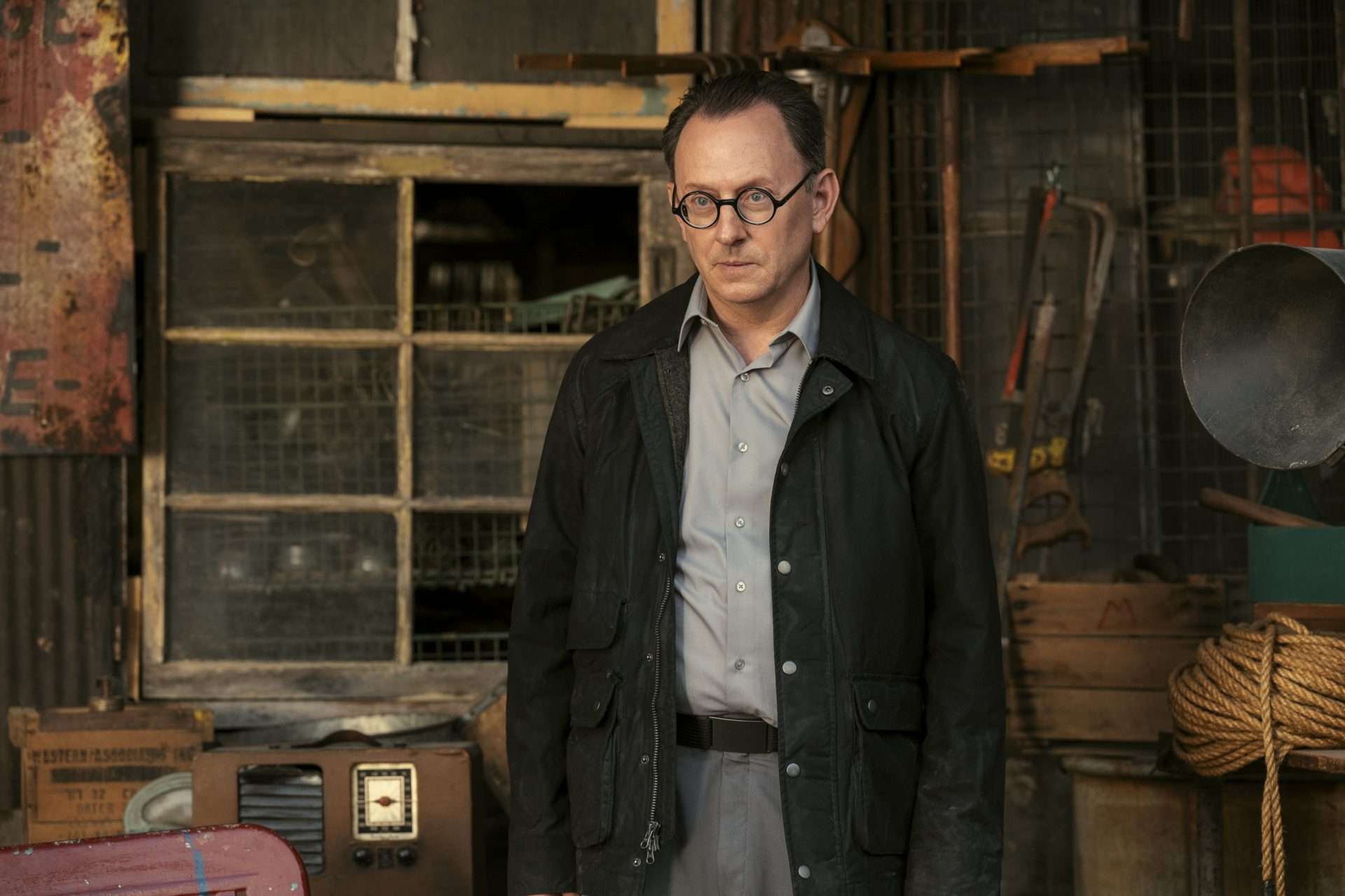
The second character introduced for the show is Maximus, a reluctant squire belonging to The Brotherhood of Steel. He is selected to be the squire for a brotherhood, Knight Titus, in place of aspirant Dane, who was unceremoniously booted out of the competition because a razor blade had been left inside her boot. Maximus is suspected of the sabotage, but he stammers through the interrogation to convince the elder of the Brotherhood to give him a shot, to which the elder agrees. He is assigned with Titus to hunt for a rogue Enclave scientist whose head contains a MacGuffin responsible for saving the world or destroying it, depending on who gets it first.
The episode ends with a group of bounty hunters finding a ghoul, Howard, buried alive. Pulling him out of the grave, the bounty hunters want to recruit him to their cause to hunt for the same runaway scientist. Howard, instead, through typical Eastwoodian prowess and Western hero bravado (reminding you of why Goggins is so good in anti-heroic roles like these), shoots the hunters down before embarking on a search for the scientist for his agenda.
Fallout (Season 1) Episode 2 – The Target
A flashback sequence reveals our runaway scientist, Dr. Siggi Wilzig (Michael Emerson), raising a lab dog he had rescued from being incarcerated as a lab rat. We also see him developing a blue chip, which he injects into his neck. One of his fellow scientists discovers him in the middle of the deed, but his faithful dog (named CX-404) manages to jump on the intruder and rip his throat out. The scientist and his dog escape from the enclave, dodging a hail of bullets.
Meanwhile, Lucy, filled with gee-willikers American optimism and 50s Americana-baked rules, almost becomes a full human-sized roach meal when she lights a fire on the wasteland. She is only saved because of CX-404 and Willzing, who had come to rest near her fire. Willzing warns her that her vault-going ways wouldn’t work on the surface, and she would have to grow up and adapt very fast to survive.
Elsewhere Knight Titus and new squire Maximus are on their way to Filly, the new shantytown cum economic hub in the wasteland. Maximus is treated as less than dirt by the jockish brute that Titus is, and the brotherhood armor doesn’t help matters. Until, while investigating a clue left behind by Willzing and CX-404, they come across a nuclear-irradiated Grizzly bear, which leads to a punch-up between the bear and the T-60 armored knight. While Titus wins the battle, his attitude towards Maximus leads the latter to withhold a stimpak (an autoinjector loaded with healing stimulants), which causes Titus to die out due to bleeding. Maximus then takes over the armor and flies out to Filly.
Meanwhile, Lucy, too, has entered Filly after a weirdly funny exchange with a barely-clad sand farmer living in a dilapidated shack. In Filly, her first stop is Ma June’s Sundries, which is a pawn shop not only filled with all Fallout memorabilia but also with the gonzo witticism mixed with the 50s Americana that characterizes Fallout’s uniqueness. Ma June thinks Vault dwellers are a bunch of rich, naive cowards, and Lucy’s interactions don’t exactly assuage her initial impressions. However, when Lucy asks about Moldaver, the woman who had kidnapped her father, Ma June shuts up and orders her to leave Filly before leaving to attend to her new customer, Willzig.
But then they are ambushed by the Ghoul, who had been waiting for them. He shoots Willzig’s leg off, which is replaced by a steampunk-looking prosthetic so forcefully inserted in the bloody stump that it almost contributes to his demise. Lucy tries to dissuade the ghoul with a speech that doesn’t affect him one bit, and shooting him with a tranquilizer doesn’t affect him a lot. He raises his gun to shoot her, only for her to be rescued by a flying Maximus. The T-60-clad squire squares off against the ghoul while Ma Squire tries to convince Lucy to accompany Willzig to her client, Moldaver. The show’s entire point is set.
Wilzig knows that he won’t make it, even with the prosthetic stump on his foot, perhaps especially because of the poor prosthetic. But even as he has ingested the banana-flavored cyanide pill, he still believes that they should continue the journey together, but with Lucy carrying the only essential part of his body—the head. He brings out the “ripper” (hand-held chainsaw) to aid her in her task before dropping the bombshell reveal—he knows she is a McClean. As the episode cuts to black, we hear his head being cut off, accompanied by gnarly, squishy sound effects.
Fallout (Season 1) Episode 3 – The Head
A flashback sequence introduces us to Cooper Howard, the popular Western star, who is very image-conscious about any characters he portrays. But even with a burgeoning film career, Howard is convinced by his wife to sign up to advertise for the multimillion-dollar company that she works for. We slowly start to realize, as he wears the clothes being given to him for advertising purposes, that the company he is shooting the commercial for is Vault-Tec. The Vault clothes were based on Howard’s get-up from the Western television show that vaulted him to stardom, and the Vault-boy cartoon logo with the thumbs-up was based on Howard’s own thumbs-up pose.
Meanwhile, Lucy, while having dinner with irradiated devil eggs, tries to inspect the head of the scientist and the blue-chip, but she gets zapped by the head, which properly dissuades her. Meanwhile, Maximus, whose armor had been damaged by the ghoul because of his aiming at a specific pressure point in the armor, leading to him flying uncontrollably and roughly landing in the forest, tries to get the armor repaired. He is a few caps short and thus would have to trade with a tooth.
When he returns, he fights off the scavengers, trying to dismantle his armor. The pow-wow makes him confident enough to take on the identity of Titus, though he is unable to stop the Brotherhood from sending a new squire. Surprisingly, the squire sent to aid him is Thaddeus, a bully of his own, and we see the darker side of Maximus emerge, where, in action, he becomes almost exactly brutish like his predecessor. Thaddeus thus brings an update from the elder: whoever gets the target will control the wasteland.
Lucy travels on through a flooded area until the gulper attacks and consumes Wilzig’s head. In the games, the Gulper is a mutated salamander. Here, they look like a mutated version of a salamander and a human, just over 7 feet tall, with his maw filled with linings that resemble fingers. When Howard arrives with CX404, he tries to get the gulper to come out by using Lucy as bait, but he is unable to get the head.
It is an example of the dichotomy of a character embittered with anger for over 200 years; cruelty comes second nature to him. But amidst the scrap with the Gulper, Lucy breaks some of the vials, making the ghoul angrier and uninterested in the head. The ghoul thus kidnaps Lucy and leads her into the waste, leaving CX404 barking towards the water.
A few hours later, Maximus and Thaddeus arrive, following the radiation signal of the ghoul but ultimately realizing that they had followed the pattern of the gulper. As the gulper is hit by Thaddeus when he shoots the monster from a distance, the gulper angrily moves towards and almost swallows Thaddeus before Maximus drags him out of the gulper’s maw, pulling his entire throat and stomach tract. More importantly, they have managed to recover the head.
As the episode ends, we witness the ghoul and Lucy walking through the arid wasteland. The ghoul taunts her by drinking water from his hip bottle without handing her any. It’s almost as if he wants her to be corrupted, her innocence almost irritating him to an obscene degree. Meanwhile, back at Vault 33, the dwellers consider what to do with the raiders of Vault 32, and Norm advocates execution, the punishment fitting the crime that the dwellers of Vault 33 are chastised about and rebuff.
Fallout (Season 1) Episode 4 – The Ghouls
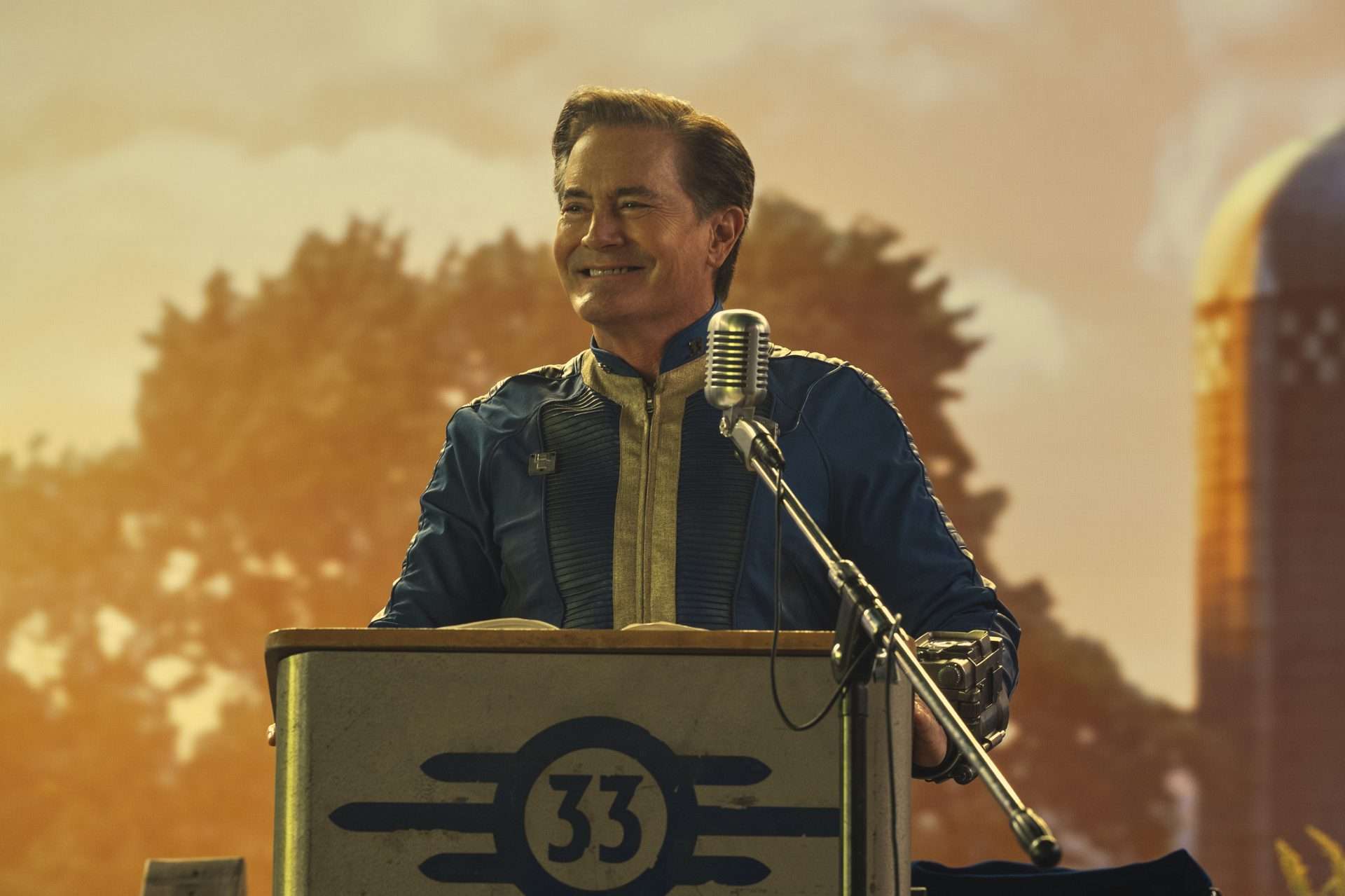
The vault storyline becomes more engrossing as Norm, disinterested in any of the tasks assigned to him, learns something interesting while delivering the prisoner’s food—that while they are unaware of the particulars of their misdeeds, the people at Vault 32 weren’t up to anything good. Intrigued, Norm and Chet—Lucy’s cousin, who is also now part of a weird family unit, which is also hilarious—begin investigating the happenings of Vault 32.
The hair-raising score and the darkened, barely lit tunnels of Vault 32 reveal something gruesome: the members of Vault 32 had presumably killed each other after having lost their minds, and bloody messages are scrawled, hinting at a dark secret behind Vault 31. Clues emerge in the dead overseer’s office as well; the raiders had entered vault 32 using the pip boy of Rose McClean, who is presumed dead, and her pip boy was buried with her. This could prove that maybe Lucy and Norm were surface dwellers.
Meanwhile, back at the surface, Lucy and the Ghoul come across a dilapidated house where Roger, one ghoul, is crying out in pain. We realize that he is slowly devolving into a zombie, and we witness a form of euthanasia from the perspective of the Ghoul as he shoots Roger down. But then we see him flip the dead body and start tearing the flesh off the dead body as nourishment.
This is step one of the ghoul trying to break Lucy’s faith in her golden rule, which he almost succeeds with the second step, where she finally drinks water from a radioactive puddle. When the ghoul suddenly begins to cough in pain, Lucy tries to escape, only to be stopped by witnessing the ruins of a city. This leads Lucy to be caught by the ghoul, and she loses a finger as a form of recompense against her attacking the ghoul and taking his finger off, apparently the most honest form of exchange they have shared so far.
They finally arrive at a supermarket, where Lucy is forced at gunpoint to be sold off to a medical robot. The robot, titled “snip-snip,” fits Lucy’s injured stump with a blackened finger from a drawer filled with stray fingers recovered from corpses before revealing his plans—to harvest Lucy’s organs. He then injects her unconscious, and she is tied up to a stretcher and wheeled into an operating table.
However, Lucy manages to dodge the saw and break her restraints, and she later injects the damaged Mr. Handy with draining fluid, which she then uses to threaten the two men who are in charge of the short-circuited medical robot. She instructs them to open the cages containing the ghouls, but that is a miscalculation, as it turns out. The ghouls start to turn into zombies, and even after Lucy takes the vials and leaves them at the ghoul’s feet, she doesn’t know that she has inadvertently released zombified monsters out in the wild.
Lucy, however, learns an important lesson about the ghoul: he needs the vials to stop his devolution into a mindless zombie until his actual mission is fulfilled, presumably. Later, we see that the ghoul has started to ingest the vials as much as he possibly can while he is surrounded by dead bodies attacked by the zombified ghouls. However, as the ghoul restarts the VCR with an episode of Cooper Howard’s own television show, the wrinkled skin and nose-removed face couldn’t take away from the effect of those nostalgia-filled eyes—he is sad.
Fallout (Season 1) Episode 5 – The Past
As the name suggests, the episode does start to reveal elements of the past without utilizing the flashback device too much. The truth becomes important as Maximus’ dark secret of not choosing to save Titus comes back to bite him. Thaddeus doesn’t take the truth very well, choosing to escape by taking away the fusion core from the T-60 armor, leaving Maximus frozen on the spot and Thaddeus with the head.
However, Thaddeus is hobbled with a broken foot caused by Maximus stepping on his leg and breaking it to an unrecognizable degree. Maximus is ultimately rescued from being dead while standing up and unable to protect himself by being ingested with roaches, due to Lucy’s timely arrival. Maximus returns the favor, injecting her with a radway to stop the effects of radiation poisoning. They make a pact—team up to find the runaway squire and Wilzing’s head—and in return, Maximus (as Titus) would convince his brotherhood to assist her in finding her father.
Historically, we learn that the New California Republic, based on Shady Sands, had been destroyed. That incident had also been pivotal to Maximus’ character, who had witnessed the destruction and also saw the Brotherhood’s armor for the first time. More importantly for Lucy, her concept of Reclamation Day had been completely shifted. The human race had already begun to repopulate, only to be wiped out due to another war. They aren’t the chosen ones; the vault dwellers weren’t anybody special.
But has that been the intention of the vault at all? There might be hints of a conspiracy here, which Norm figures out. He learns that every single overseer of Vault 33 belonged to Vault 31, and now the current overseer election results in Betty’s win, who had also been a part of Vault 31. If the only remarkable difference between Vault 31 and Vault 33 is the quality of the mashed potatoes, that doesn’t explain Vault 32 being completely cleared of all traces of violence and blood and cleaned up for rehabilitation.
Meanwhile, Lucy and Maximus come across two drifters, and they try to cross the bridge, raising their hands, only to be shot at by the drifters. Maximus shoots them back, taking the gun forcefully out of Lucy’s holster and shooting them. Maximus is, however, shot, and Lucy, to ensure that it doesn’t take a turn for the worse, drags him to an abandoned office building—Hawthorne Medical Laboratories. However, while exploring through the building, they are both knocked out and dropped down below the surface. When they wake up, they realize that the office is an entry point for a new vault, apparently Vault No. 4.
Fallout (Season 1) Episode 6 – The Trap
Episode 6 is where the true history of America, pre-war, is given focus. We witness Cooper Howard becoming a pro at giving advertisements the hint of who the Hawthornes are and what Vault 4 might actually be. Moreover, we witness how McCarthyism and the Red Scare evolved into directions specifically gonzo and yet somehow realistically terrifying in their uncertainty. We also realize how the end of the world and post-apocalypse would ultimately come down to “management” if the bigwigs at Vault-Tec, with their nuclear fallout shelter plans, have anything to go by.
But even within all that, Howard learns how Hollywood has begun to ostracize him because he is becoming the unwelcome soothsayer, how even the vaults are divided according to a class system, and how Howard’s wife is trying to ensure they get the best of the vaults once the inevitable occurs. Due to the arbitrary rules of no dogs being allowed in the vaults, it seems to Howard that while the inevitable could be ignored until it couldn’t, even after the aftermath, the capitalistic shackles and old world order would still exist. Until Howard is approached by an old friend, Charlie.
He is friends with Howard because he has shared the most screen time with him, having to play the role of a native American as the villain. It’s a suitable dig at American films of the 1950s, but what is truly fascinating is Charlie’s informing of a group dedicated to revealing the true insidious nature of Vault-Tec. Selling the vaults would only be profitable to Vault-Tec if the threat of a nuclear exchange persists. The success of peace talks would be antithetical to Vault-Tec’s agenda, and thus, they have a vested interest in a great war occurring. He invites Howard to the meeting.
Meanwhile, in the present timeline, a vault dweller explains to Lucy that most of the inhabitants of Vault 4 are refugees from the surface. The difference between Lucy’s vault and Vault 4 becomes more pronounced when Lucy and Maximus are introduced to the Overseer Benjamin, who is pretty genial and welcoming, aside from the fact that he is a cyclops. That meeting almost opens Lucy’s eyes, and she finally notices that most of the inhabitants of Vault 4 have mutations.
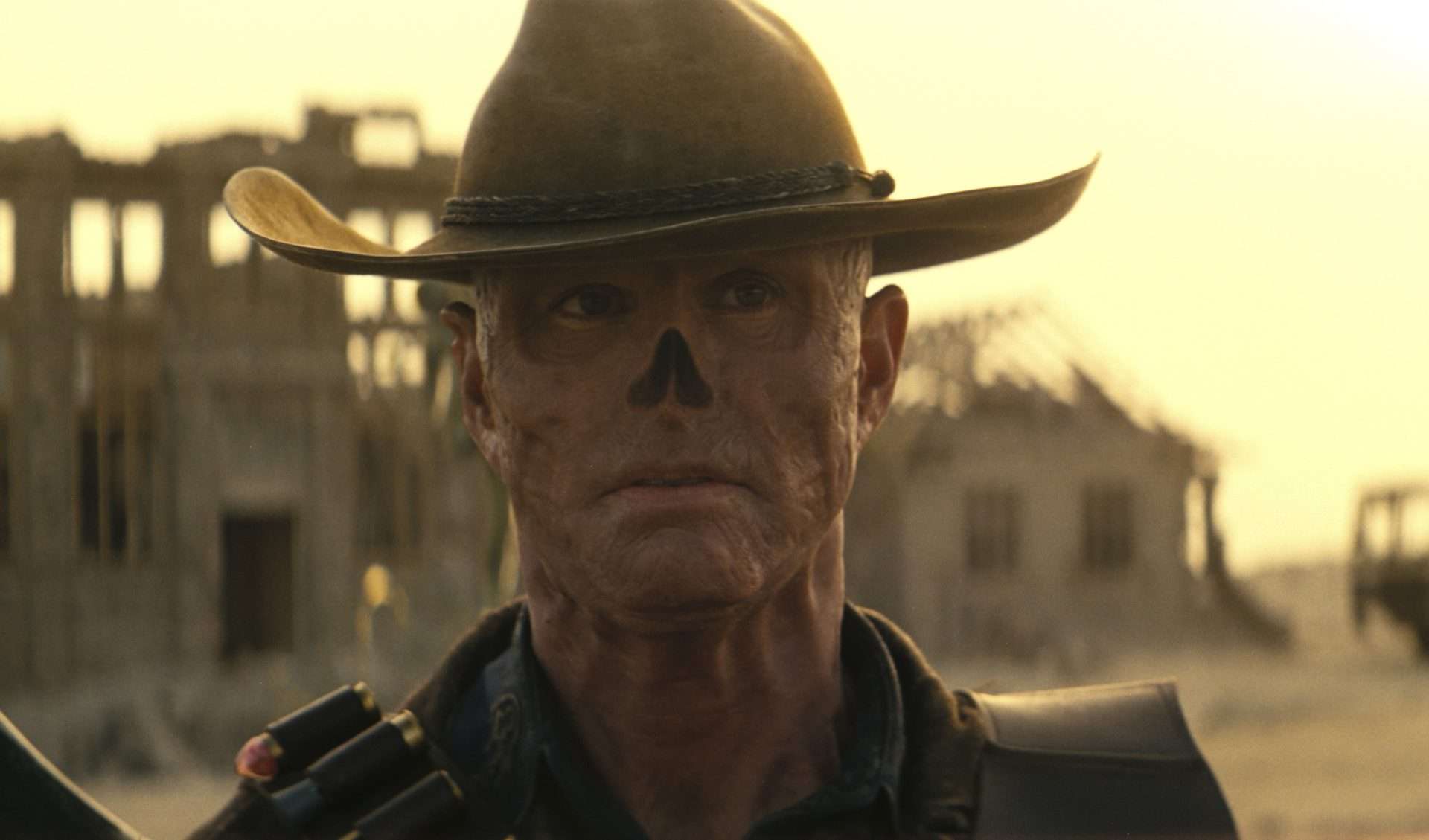
While Maximus is introduced to the high life of living in a vault—a hot shower, caviar—Lucy explores the vault, finally coming to a classroom. A blackboard that sets up the modern-day history of the world gives context to Lucy as well as the audience. According to the Fallout history, which is shared between the games and now this TV series, Shady Sands was formed in 2142 and the New California Republic in 2189. While NCR becomes the largest political power in 50 years, its capital city would soon fall in 2277, four years before the events of Fallout: New Vegas, which might be a retcon, though my game knowledge could also be a bit spotty.
The weirdness begins now when Lucy follows a gathering of some of the members of Vault 4. Apparently, this is a ritual only conducted by the surface dwellers, where the paganistic ritual would be followed by the members undressing themselves, rubbing their bodies in the “ashes of Shady Sands,” and then drinking blood, all in the name of the flame mother, AKA Moldaver.
Needless to say, Lucy is overwhelmed and creeped out, and she goes to warn Maximus only to find him completely besotted with the vault life. He is now very interested in following up on Lucy’s offer to have sex. She is, however, distracted and tries to warn him, ultimately promising to prove they are hiding something. However, her meeting with the Cyclops overseer doesn’t provide her with satisfactory answers, so she goes off to snoop around Level 12, where she had been warned not to snoop around.
Meanwhile, back on the surface, the Ghoul is captured by members of the government and their president, a local mafia gang in place of the NCR, and the Super Duper Mart organ racket has been under their protection, and he wants the Ghoul to be eradicated. Instead, the ghoul kills all the members of that government before seeing a bounty poster of Moldaver, whom he recognizes, though that is not the name he had known her by. The Ghoul, AKA Cooper Howard, had known Moldaver over 200 years ago as the leader of the secret group whose meeting he had been invited to attend by Charlie.
As for how Moldaver had been alive for over 200 years ago, that question would be answered by Lucy as she snoops around Level 12. She finds a lab where the corpse of a gulper is preserved for experimentation, a video of a pregnant woman giving birth to piranha-like creatures that start feeding on her body underwater and videos of the Hawthorne conducting experiments that would lead to the destruction of their lab in Vault 4. But the secret she identifies before she is caught by the Overseer is the freezing pods housing the bodies of presumably older members of Vault-Tec and other dignitaries. That would explain how Moldaver is alive.
Fallout (Season 1) Episode 7 – The Radio
In the past, we learned that Moldaver, or Ms. Williams, as she had been known back in 2077, was one of the leading Hollywood Reds, inclined to blame more on their enemies at home than the enemies of the east that had led to the massive resource war that Cooper had fought in. This thus leads to a fiery exchange of words that ultimately reveals Ms. Williams’ intentions: she had discovered cold fusion as a viable energy source that would end the resource war, but Vault-Tec had bought her company out and kept the cold fusion technology under lock and key, such that their own capitalistic ideals would not be stopped. Cooper thus reluctantly agrees to spy on his wife to learn the truth about Vault-Tec.
Back in the present, the residents of Vault 4 bring her to the atrium to judge her for her transgressions, but she misjudges them because instead of sacrificing her as she had expected, they let her go, even giving her food for her journey. Apparently, the experiments she had witnessed in Level 12 were older experiments done by the previous inhabitants of Vault 12, who were turning residents into gulpers until the gulpers had fought back. Now, the new residents are very cognizant of not repeating the same mistakes.
That doesn’t stop Maximus, who had seen Lucy being dragged to the atrium, from breaking off from his stupor, getting armored, and even stealing a cold fusion backup power for his armor and attacking them until he is called off by Lucy. Later, above the surface, Lucy requests that he return their power source. Otherwise, the residents of Vault 4 would only survive for weeks, which Maximus reluctantly agrees to.
As Maximus and Lucy return stealthily back to the vault to return to the fusion core, we see seeds of romance blooming ever so much between the two of them. Lucy asks whether Maximus would join her back in her vault, where, while they don’t have caviar, she has canned tuna. However, Maximus would have her company, and he would belong. Maximus, guilt-ridden, reveals that he is not Knight Titus, and he had been pretending all along. But by this point, Lucy has had enough of mistrust in the surface world. Considering she had thrown acid over an innocent man’s face, she doesn’t like this version of herself in the wasteland, and she is okay to trust this stranger.
Trust, though, is a scarce commodity for Thaddeus, who had been carrying the head all the while his broken leg was slowly getting worse. He had left CX-404 in a Nukka Cola fridge while walking towards a radio station to call the Brotherhood for backup. He meets a thespian snake oil salesman who manages to manipulate him to sell a miracle cure for his foot in exchange for the fusion core Thaddeus had stolen off the T-60.
Later on, Thaddeus manages to convince the services of a DJ of a radio station (how weird, a radio station in a post-apocalyptic wasteland), whose station is surrounded by booby traps. However, he is suddenly met by Maximus and Lucy, and before he can attack them, he is shot by an arrow that passes through his neck and gets stuck but doesn’t kill him. Apparently, the medicine had turned him into a ghoul. That news is enough for Maximus to take the head; Thaddeus runs away, considering the Brotherhood can’t stand mutants. As Maximus explains to Lucy, it’s a complicated organization.
The members of that complicated organization are coming, having received Thaddeus’ message. Realizing there is no way out, Maximus takes one of the stray heads on the ground and hands over Wilzig’s head to Lucy, ordering her to go find Hank. Before they separate, they finally kiss, cementing the beginning of a sweet relationship amidst this sour wasteland.
Back in Vault 33, Norm has had enough. The raiders were poisoned to death, and some inhabitants were transferred to Vault 32. Norm takes the necessary steps, and he finally hacks through the overseer terminal and contacts the overseer from Vault 31, asking for a meeting. The Vault 31 overseer agrees to it, fearing she might be compromised.
Fallout Season 1 Episode 8 “The Beginning” Ending Explained:
What was the truth about Vault 31?
This is the episode where all revelations through multiple timelines converge and collide, as well as multiple factions, meet and converge in a set piece of gore, gunfire, and blood. But in the end, Fallout within the gonzo black-comedy tone works well because the revelations are a result of the closure of all the character arcs, which were mostly effectively developed throughout the season.
Cooper Howard listens through the bug planted in her pip-boy. That affects her pip-boy, leading to him following her inside the main office of Vault-Tec and learning about the heartbreaking final plan. For one thing, it’s a matter of conviction, and the fact that his wife is not just agreeing with the company line but actively emphasizing and pitching their wild plan to all the bigwigs of the corporate world means that each vault would be a crucible for them to conduct their outrageous experiments and produce their idea of society. But that could only be possible if they dropped the bomb and took charge of the nuclear exchange themselves. The fact that Cooper and his family would be saved at the cost of such a huge sacrifice and the destruction of the world due to shared corporate greed strips all his idealism away.
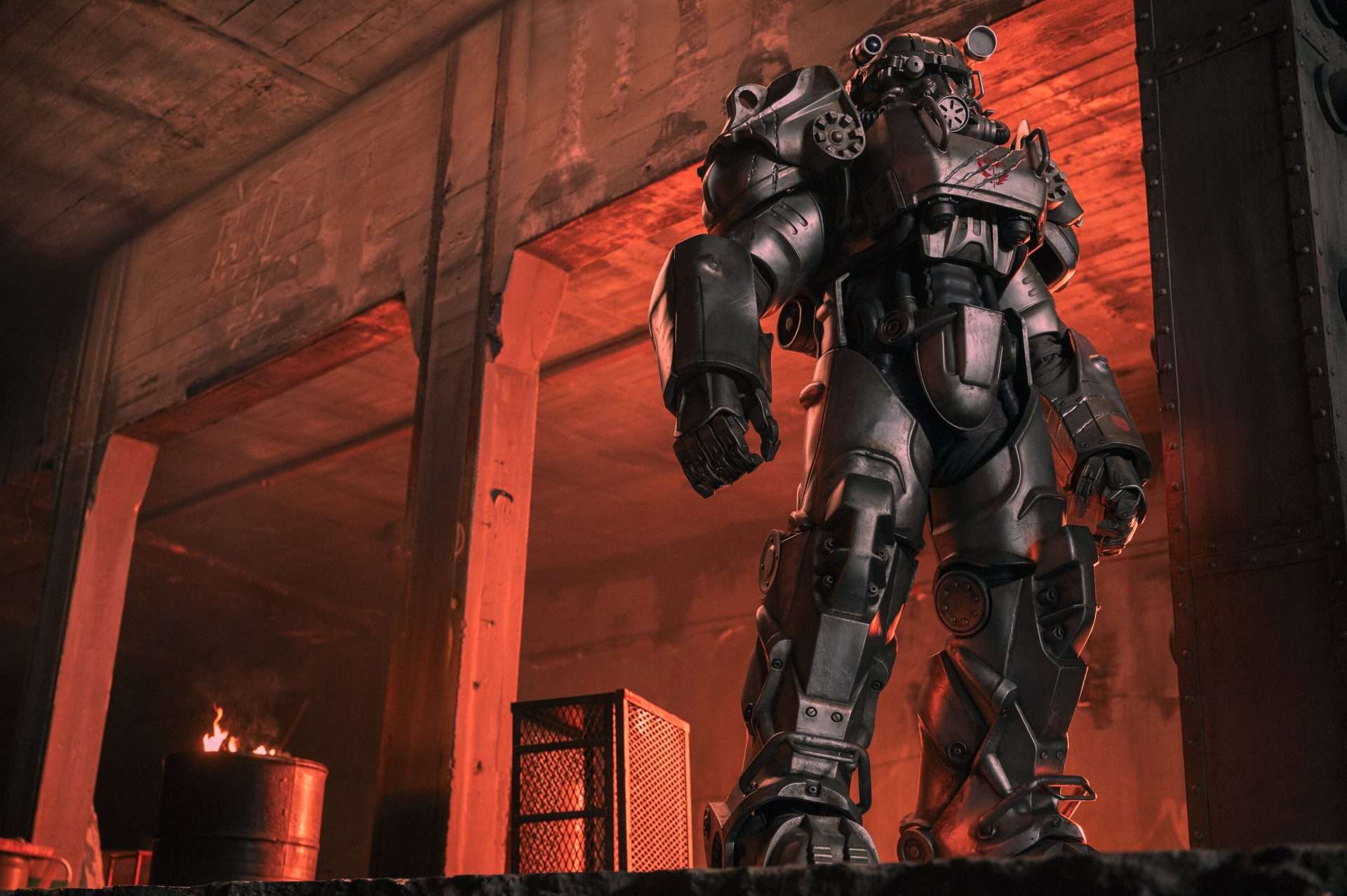
For Norm, back at Vault 31, he meets his overseer—a brain on wheels, armed with a syringe and installed with a program to inject any of the intruders by any means necessary. Through questioning and ignoring the protestations of the brain (who is literally Bud Askins, the marketing head of Vault-Tec who had been pestering Cooper throughout the show in the past), Norm learns the horrifying truth: all the overseers of the vault had been Vault-Tec management officials, frozen inside crypods and unfrozen during a specific cycle to head a specific era of Vault management within a specific timeframe. More importantly, Hank McClean had been born not only before the vault. He was the new assistant hired under Cooper’s wife and a huge fan of Cooper, who had wanted an autograph of him. This is the reason why Cooper remembered the McClean name.
For Maximus, his subterfuge doesn’t last long as the elder figures out that the head is a fake, but Maximus manages to convince the elder that he could lead him to where the real head is located. The aspirant Dane also confesses that they had put the blade in their shoe to take themselves out of the running for squire, and thus, they had been indirectly responsible. The Elder concedes Dane’s proposal, grants Maximus mercy, and privately presents a proposal: if Maximus could lead them to the head, the Elder would grant Maximus knighthood and a chance to rule beside him.
Lucy meanwhile reaches the Griffith National Observatory, which had been repurposed as a makeshift base for the remaining rebels of the NCR. As she meets Moldaver, she also finally locates her father, trapped within a large birdcage. But the revelation of her father’s true allegiance is also tinged with a sense of tragedy—not only is Lucy and her mother part of the NCR, but her mother is currently a rotting ghoul sitting at a table behind Lucy.
The resultant transformation had been caused because Hank had been instrumental in the bombing of Shady Sands, as another successful civilization above ground would prove to be detrimental and an existential threat to the Vaults, as well as Vault-Tec’s own “golden rule” and the never-supposed-to-come-to-fruition dream of “reclamation day.” In order to trigger the cold fusion Wilzig has been holding inside his skull, Moldaver needs Hank to provide her with the code. Lucy requests that Hank turn over the code after learning the truth about him, and he grudgingly complies.
Meanwhile, Maximus manages to lead a squadron of Brotherhood soldiers to the Observatory, where they begin systematically attacking the NCR headquarters. But the brotherhood soldiers are met with a rude shock as they find the Ghoul waiting for them, armed with the knowledge of a weak spot between the armor plates that hadn’t been improved from the T-45 to the T-60 iteration. That results in the violent, bloody dispatching of these Brotherhood soldiers.
Meanwhile, back at the observatory atrium, the emotional weight of the revelations leaves Lucy in a daze. She is unable to notice Maximus or that Hank has managed to free himself by manipulating Maximus before taking control of a suit of Brotherhood armor and knocking Maximus out. As Hank prepares to fly out, he tries to convince Lucy, who instead points the gun at her, intent on shooting him. She doesn’t get the chance because the ghoul shoots at Hank, leaving him with a scar, before asking and revealing his true agenda: Cooper Howard has been searching for his family for over 200 years, and now he wants answers. Hank doesn’t answer, instead choosing to fly away.
As Hank flies off, the ghoul offers Lucy a choice: either stay with Maximus or follow the ghoul on a quest to find her dad. The ghoul had attached a tracker to Hank so that he could track the man down. It is effectively a resettlement, but now the intention is different, and Lucy agrees before shooting the ghoul that had been her mother through the skull, ridding her of the misery of the undead.
As the ghoul and Lucy begin their journey, we witness lights starting to light up near the Griffith Observatory. Before the fateful events of that day, we had seen the colony surrounding Griffith Observatory almost resembling one of the Vaults, or more importantly, hearkening back to what the NCR had been before. In her dying breaths, Moldaver manages to activate the cold fusion device, supplying power throughout the observatory—a replenishing energy source. As Maximus slowly regains consciousness, he sees lights return to the observatory, and he takes credit for the “win.” Moldaver wonders what the Brotherhood would do with ultimate power. It’s an answer we would have to wait for next season.
The final shot shows Hank, travelling in the Brotherhood armor without the faceplate, affected by radiation, walking through the desert wasteland into a ruined but gleaming cityscape of New Vegas, where ostensibly the “management” of Vault-Tec actually resides. Hopefully, questions will be answered, but more questions will also be raised for the next season.
Fallout Season 1 Review:
While last year’s “The Last of Us” was a definite step forward in proving the video-game adaptation slump is all but over, “Fallout” is almost like a sledgehammer, slamming that statement into the ground for posterity. The difficulty in adapting “Fallout” had been enormous because it’s not enough that “Fallout” had a very recognizable aesthetic or that it was playing in a post-apocalyptic sandbox that is a very attractive story-telling sandbox. “Fallout” has a very specific, gonzo tonality, with black comedy and gory mayhem as well as tongue-in-cheek satire existing in equal measure. Ostensibly a fun adventure story, “Fallout” is also supposed to be a commentary on greed, capitalism, religious fundamentalism, and American exceptionalism that had been such a trademark of the 1950s, armed with Cold War paranoia, which just never died out.
Co-creators Jonathan Nolan and Lisa Joy, along with writers Geneva Robertson-Dworet and Graham Wagner, completely manage to capture the tonality of the games in the dialogues as well as in the situational humor and the bizarre adventures. The tonality itself allows for the visual effects to be a bit more noticeable and cartoonish, lending to the sense of artifice without losing or managing to pull you out of the narrative. It is fascinating how the detailing and the choice to introduce just enough of the world attract not only new fans of the world but also older fans of the game to follow the narrative without getting lost in the minutiae of the tapestry.
According to Todd Howard of Bethesda Studios, the show is set within the same universe as the games, but the careful world-building places it almost squarely as a sequel to the previous game of the series as well as acting as a fresh jumping-on point. It also gives the seasoned veterans of the game newer avenues to explore, especially the pre-war era with its own politics and machinations, and those are always fascinating to witness in all their glory rather than being given information through scraps of paper and snatches of code. The retro-futurism contrasted sharply by the post-apocalyptic progression of this world feels very much part of a piece, a successful recreation of the aesthetic of the game in a completely separate medium, and the production design becomes an especially important constituent of the series as a result.
But what truly sells the show is also the cast and the characters. Walton Goggins as the Ghoul is exceptional. His is the most showy performance, and as the ghoul, he is completely at home chewing up the scenery and being casually cruel and vindictive in his hatred. Its in sharp contrast to his portrayal of actor Cooper Howard, the idealistic Hollywood star whose worldview slowly starts getting chipped away as the reality of the inevitability becomes crystal clear to him.
Ella Purnell, as Lucy, has a hard job of selling the naivete of the main character without coming off as a blank slate or becoming too naive to be almost called idiotic. Purnell brings a natural charm to Lucy that makes her a believable character to follow and one to root for, even as the truth of her faction (the vault dwellers) becomes abundantly clear. In contrast, while Maximus (Aaron Moten) is given a meaty role as a darker, conflicted protagonist, he is ultimately reduced to a comedic punchline. Until their paths cross with Lucy, Maximus and the Brotherhood storyline are easily the most ancillary bits of all the subplots.
“Fallout” also feels relatively less self-indulgent than Nolan and Joy’s previous endeavor, but that could also be attributed to the wacky tone and general lack of seriousness. There isn’t an imposing, somber tone to the proceedings, which allows for the adventure to take its due course even when the plot progression feels somewhat redundant and checkpoint-heavy (like a video game).
Thus, while mystery box storytelling is, of course, a part of the story, especially in the exploration of the truly insidious nature of the vaults as well as the shuttling between two timelines, they don’t overwhelm the narrative or become the only defining characteristics. They are part of the overall strange story that the creators have set out to tell, and there is a genuine honesty and love for the source material that would translate to newcomers to the franchise as well.
Easily one of the most appealing and surprisingly fun shows of the year. Even though the pacing is at odds with how stuffed the show actually feels, there is an admirable economy in how it parses information about the world and its characters.





